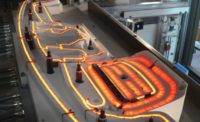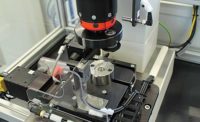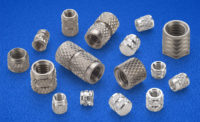Taking a part that was assembled from several components and reducing it to one 3D-printed part has obvious benefits like weight reduction. But there are also other value propositions that start from the beginning of the design phase and reach towards end-use safety and reliability.
Take an example air duct. The original, conventionally manufactured design consisted of 16 individual components—the external enclosure, an internal baffle as well as screws and washers. Now, take that part and redesign for manufacturing with a 3D printer: One part, one component. Or, on the other end of the complexity scale, take an example of a turbine blade assembly that was reduced from 300 components to a single part.
“When you look at reengineering that exact same part as a single, consolidated component, obviously the first impact here is one part, one part number,” says Patrick Dunne, vice president of advanced application development for 3D Systems. “It’s one part that needs to be certified, one blueprint.”
As he explains, the value proposition extends beyond the end product. It starts back at the design phase, with an engineer designing one single part with end functionality in mind, instead of 16 parts with an engineer designing for manufacturing assembly.
“So the value proposition begins as soon as you start thinking about using additive manufacturing as the tool of production,” he says. “It’s not just the value proposition from production; it’s the value from the simplification of design. There’s no tooling involved. There’s a lot less labor. I’ve always said 3D printing is just a subset of automation. And if you think about assembly, all the workers at an auto plant, what they’re doing is assembly. And there’s opportunity for error in assembly if you forget to put in a screw. Or in the case of welding components, there’s less opportunity for porosity, or defects or voids in the welding.”
To learn more about consolidated part assembly, Appliance DESIGN asked Dunne for his insights on consolidated part assemblies.
appliance DESIGN: Do you ever find engineers who are new to 3D printing reverting to traditional thinking—designing many small components which would then have to be assembled like they would with conventional manufacturing. Or is part consolidation too inherent to 3D printing for that to happen?
PATRICK DUNNE: That’s a really good question. Typically if you drop a CAD file that was designed for conventional manufacturing into a 3D printer, you just get a more expensive part. You don’t tap into any value at all. And that is a mistake that some companies make when they’re benchmarking. They’ll literally send 20 STL files and ask you to print them all, and then they’ll weld them altogether. And they’ll look at it and go “Well, that’s more expensive than casting, why are we doing this?” And then they’ll move onto something else. It’s just like any technology, if you don’t understand the value proposition, you tend not to tap into it. If you don’t tap into it, then you cannot derive any value and you misunderstand the capability.
AD: What are the limitations for part consolidation, where is the avant-garde, embedded electronics? Joints, hinges, moving parts?
DUNNE: There are very little embedded electronics going on, to be honest with you. Most is more academic or more experimental.
Integrated mechanisms are a derivative of consolidated components, and we do see that. There is a great example of an electronic enclosure where a company previously had a living hinge. And the company spent several months trying to 3D print a viable living hinge, a very thin piece of plastic that will open and close. It’s actually quite difficult to make a living hinge with a 3D printer that’s as good as an injection-molded living hinge, just because of the nature of the types of plastics and the ductility of some of the plastics that are utilized.
So the company spent several months trying to refine a living hinge. At the end of the day they realized, why build a living hinge when we can build a real hinge, a hinge with an actual axle? And so … the CAD files are essentially an assembled hinge assembly that works perfectly, they were better than an injection-molded living hinge. You can open and close it endlessly; they also integrated a latch mechanism, like a little snap fit. They ended up with a product, again, that was better.
But what that solution was reflective of was an engineer thinking outside of the box, and not attempting to take a conventional injection molding design and drop it into a 3D printer and expect to tap into the value. 3D printing is another tool in the tool box that has strengths and weaknesses, but very significant and unique capabilities when it comes to design complexity. And that’s what they were tapping into with this hinge.
AD: That goes right along with what you were saying about moving away from conventional thinking.
DUNNE: Right, when I work with engineers from different companies, you can tell instantly when the designer gets it, because straight away they’re producing what I call design for functionality vs. design for manufacture.
The traditional process for design is really a process of compromising functionality to make something manufacturable. When you design for manufacture, it’s a process of compromise. Compromising capability. Whereas with 3D printing, when you’re working with an engineer, and you see they are no longer thinking about these traditional rules that they’ve learned about how they should and shouldn’t design their product, and they’re thinking more in terms of designing for functionality, and disregarding the constraints of design for manufacture, essentially.
AD: Looking ahead, are there new materials that will allow for consolidation of parts that might not have been possible in the past?
DUNNE: On the metals front, if you look at the titanium right now, the titanium that is coming out of 3D printers is better than cast titanium, significantly better than cast titanium. Some of the medical-grade titanium they’re coming out with right now has properties that are cyclic fatigue resistant, ductile titaniums. This is really intriguing, right, because traditionally people have said to themselves “the materials you get out of 3D printing are not comparable to conventionally manufactured parts.” But the way things are trending, it seems like what we’re ready to arrive at is that the properties of 3D printed technologies will actually exceed the capabilities of conventional manufacturing.
AD: How is that possible?
DUNNE: In the case of titanium, you’re taking elementally pure titanium and producing the powder in an argon environment without exposure to oxygen. You’re putting it into a machine that’s building the titanium in a 25-part-per-million oxygen level, again, a pure environment. So you’re getting microstructurally purer metal parts that are better than what you get even with castings. With casting, there’s contamination from the crucible, and the turbulence of pouring mettle into a mold and the bulk cooling.
What we’re seeing now is that when it comes to risk adversity, I think we’re going to see a tipping point where we produce parts with a digital technology, as opposed to an analog technology. If you think of casting as an analog process, melting and pouring and there’s gasses and bulk cooling and shrinkage and tension and distortion. As opposed to a digital process where you are manufacturing every single voxel of that component using a laser that’s under very high frequency power control. You get to a certain point where there would be more risk with using traditional techniques than digital techniques.
AD: What are some ways part consolidation reduces risk?
DUNNE: If you look at GE’s turbine blade assembly, traditionally that was 300 parts. It required 60 design engineers to design and engineer 300 parts. The consolidated version of that product, it’s one single file. That’s a part consolidation ratio of 300:1. And again, because you’re not designing individual components that need to be jigsaw puzzle pieced together, it went from 60 design engineers to eight design engineers, which is remarkable.
When you go from 300 parts to one part, it’s simpler, and a subset of simplicity is time and money and errors and things that don’t fit together and vendors and certifications.
And the biggest thing is risk aversion. If you have 300 individual parts that are all exposed to a risk profile, and then you assemble those 300 parts, every single weld line, every single bolt, every single thing that has to be inspected represents risk, represents uncertainty, represents points of failures. Or, if it’s one single part, there are no weld lines.
AD: What parts are possible now because of additive manufacturing that were not possible before?
DUNNE: In medical, spinal fusion cages are a really good example. An optimal fusion cage has two characteristics. One, is it has a porous lattice structure integrated into the geometry. The purpose of the porous lattice structure is twofold. One, it allows for bone ingrowth and so you get what’s called osteointegration. You get a really good fusion between the bone and the implant. The bone cells will grow into the porosity. And the second thing is the engineers are able to selectively modulate the density of the lattice structure, within the implant such that it flexes in a way that’s reflective of true bone structure.
If you look at true bone structure, it has essentially a lattice structure. And by engineering a lattice structure into an implant it prevents a phenomenon which is known as stress shielding. So traditional machined titanium implants—they were mechanically robust and strong—but the problem with CNC machined implants is that the bone structure above and below the implant and behind the implant has a tendency to wear away as a function of atrophy. Because if the implant is holding all the tension and compression, then the body will essentially start to dissolve the bone cells and remove them because they’re not performing any function. But by intentionally engineering flexibility and weakness into an implant, they prevent stress shielding.
So if you look at the medical industry and all the big implant companies that are utilizing 3D printers, they are producing implants that are better than anything they were capable of producing using conventional techniques. So it’s enabling new products and new capabilities.
This interview was edited for length.






